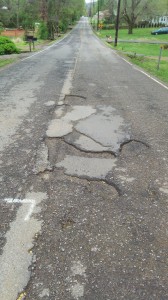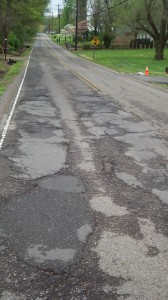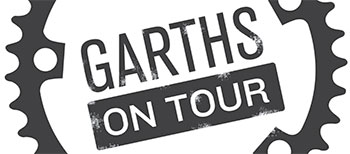Last week, a friend and I made a two-hour road trip to visit another of our friends from college . It was a particularly windy day, as storms were brewing off to our west. Even from the comfort of her minivan, we could feel some of the impact from the heavy headwind into which we were driving, and that sparked a conversation about how the wind affected Dave and me each day on our bike tour.
“Bethany… I just never even thought about how much of a difference that would make,” she said, after I explained how much a headwind would slow us down significantly, or how a good tailwind could carry us twice the distance.
“I know,” I replied. “I didn’t realize as much before either, because honestly, when you’re in a car, it just doesn’t make a noticeable difference.”
“So that saying, ‘May the wind be at your back,’ is actually pretty powerful isn’t it?” she said. “I mean, to speak that to someone is to really give them a blessing,”
And at that point in the conversation, I realized 200 years ago, no one would have NOT understood the impact of that well-known blessing. But our culture now is so insulated, so protected. We travel so much in enclosed vehicles and spaces, protected from the elements and thus unaware of the impact they may have on us.
I told my friend that now, no matter where I am, if I see a flag, I notice which way it is blowing in the wind. I think before our tour, I really didn’t notice flags at all, and I couldn’t have cared less if they were flapping in the breeze or in which direction. But now I always see them. I am ALWAYS interested in how the wind is blowing, even if I’m in my car. It just became a part of my life to take note of that detail. And I kind of like that I’m aware of it now, even when I’m not cycling.
I realized that is one of the ways I see the world differently as a result of our journey. So what are some other ways?
Weather in General
Actually, we’d say we are more aware of weather altogether, and its impact (or lack thereof) on our daily lifestyle. Just last night at work I heard some guy complaining about having to walk to his car in the evening shower. He was wondering if there was an umbrella he could borrow. I told him I was about to head home on my bike. He stopped complaining and agreed he probably wouldn’t melt on the way out to the car. (I was fortunate, however, that the rain had basically stopped by the time I needed to commute home! Perfect!)
But seriously… these days, if we need to make a dash out to the car in a downpour—it’s just not that big of a deal. Because we know that afterward, we can drive in the completely insulated environment of our vehicle from point A to point B. We might show up with a few raindrops on our shoulders or with the bottoms of our pants wet… but we don’t arrive in a completely sopping and saturated state. Even if we ride our bikes in the rain at this point, it’s only a few miles here and there, and when we arrive, we take off the wet stuff and simply change into something dry. What a luxury! I guess you could say our perspective of rain being an inconvenience has changed—it just doesn’t bother us much!
Scale of Distance
Our perspective change goes beyond weather conditions. We’ve come to a new understanding about scale of distance and terrain. One of the realizations that comes along with that is how most people have NO SCALE. Just the other day we were talking to our new friend Taitee, a Malaysian guy from Portland (I know, right?) who’s on a long bike tour. I met him while I was working at REI, and Dave and I took him out to dinner a few days later. We shared stories about bike touring and the interactions we would have with “normal society.” Dave mentioned this issue of people having little or no scale for distance, and Taitee said, “This is why I never ask people for directions. I only ask Google.” Well-said, Taitee!
We noticed it most on our trip… if you ask someone how far something is, or how the terrain might be between here and there, they will never tell you they don’t know. They will give you an answer. And 90 percent of the time, that answer will be WRONG. They know it takes them 10 minutes in the car… “must be close” they think. They cruise right over the long, steady uphill between here and there… “It’s completely flat,” they tell you of the route. We, like Taitee, finally realized we were probably better off not asking someone unless they happened to be a cyclist. Cyclists always know, either because they’ve ridden it before or they’re used to paying attention even when they drive it. And thus we see the world as well. We know how many miles/kilometers it is to the closest grocery stores, to work, to a good coffee shop. And we know the terrain between here and there. And we’re working on expanding our knowledge to the entire area, as we explore both by vehicle and by bike. But in general, we’d say we have a good grasp on distances… probably a better grasp than a random Joe.
Road Quality
To be honest, I never used to notice a bump in the road unless it was enormous… like maybe an actual speed bump. Not so anymore! I notice every manhole, each valve cover and even the tiniest potholes. Because on a bike, any one of those things could jar me significantly as I pedaled along. And that doesn’t even include just the general surface and smoothness of the actual asphalt! But I am now fine-tuned to the quality of every road on which I travel—whether by bike or by car. I have noticed that when I’m in the car, it kind of bothers me if I have to hit a small pothole or drive on a portion of slightly bumpy road. I catch myself making slight maneuvers to miss manholes—even though that doesn’t matter much in a car. And of course I still notice it when I’m on my bike! I think Dave was probably already fairly tuned in to this because of the years of cycling he had under his belt before our trip. But even he has an increased awareness. So now we catch ourselves having repeated conversations about road quality in different parts of town on a regular basis—because we’re both noticing it all the time!

There’s one stretch of road in Nashville that we absolutely LOATHE because of its many potholes and bumps. We think it could be the worst 200 meters of road in the city!

Same stretch of road, different portion. We must not be the only ones who think it’s so bad, either, because when I was out taking these pictures, some guy pulled over and asked me to send them to the city councilman over this district!
We continue to realize how our time on the Tour affected the way we see and understand the world in which we now live. I’m sure there are more ways, but we just don’t know them all yet! I hope we continue to grow and expand our view of the world… even without the help of the Tour!


4 comments
Victoria Cumbow says:
Apr 15, 2014
I love this, Bethany! It’s so true. I haven’t ridden as extensively as you or Dave, but I see a few things differently as well. One of my first long rides alone, I remember being on a road that was a slow, painful climb. It wasn’t noticeable in a car; I’d always considered it a flat road. On a bike, however, it wasn’t flat at all. It was three miles of a gradual increase, and at the time, I was still inexperienced. I’ve learned since then.
But one of my favorite things about cycling is seeing the world (or more specifically for me, my community) differently. You see things on a bike you don’t notice in a car. It’s beautiful and refreshing, and I appreciate my home so much more. Thanks for sharing this insight!
Kim Schutte says:
Apr 21, 2014
Cool post! You’re right about the wind (and everything else too, but it was the power of a headwind that was most shocking to me when I started riding.) The terrain point is good too. I thought I lived on a flat street until I bought a bike!
So I have to ask (so I never try to ride down it!)–what road is that?
Lilla says:
Apr 26, 2014
Insightful post.
Thomas says:
May 10, 2014
So well said !
I noticed exactly the same thing with friends and colleagues (they complain a lot and, …you know, french people complains a lot 🙂 – specially about weather).
Once again your post is amazingly wrote (love it, still reading you a lot) and sooooo true !